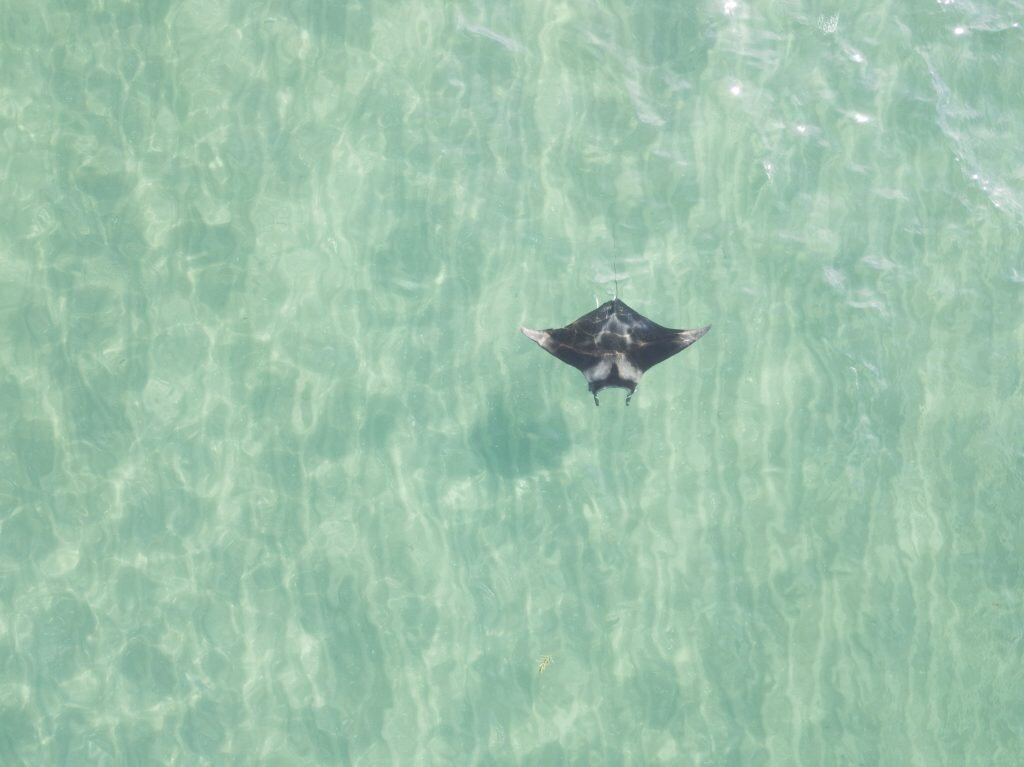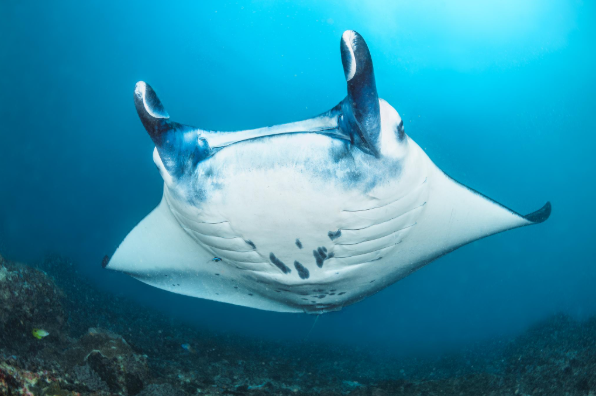Urban Mantas: A potential nursery ground for manta rays may be under threat off southeastern Florida
The first study on manta rays off the coast of Florida, published today by Endangered Species Research, has discovered a potential urban nursery ground for manta rays.
Juvenile manta rays were regularly sighted in the shallow waters along Florida’s coastline, the first time a nursery habitat has been discovered in such a highly developed urban environment.
Conducted over a four year period, the study revealed that almost all mantas sighted were juveniles, with individuals using the habitat throughout and between years, both of which are key definitions of a nursery ground.
“Manta rays are rarely seen by divers on Florida’s reefs and most divers are surprised to learn that we have a potential manta nursery ground along our coast,” said the lead author of the study, Jessica Pate from the Marine Megafauna Foundation (MMF). “In many places, manta rays are seen at remote cleaning stations along coral reefs systems or feeding offshore. Here in Florida, we regularly see manta rays swimming in 5 ft of water over the sand in front of multi-million dollar mansions or high rise hotels and apartment blocks. They rest in man-made inlets and feed at the mouths of inlets which have heavy boat traffic.”
Mansions along Florida’s coastline overlook a potential urban nursery ground for manta rays. (c) Jessica Pate, lead author of the study
Researchers from MMF conducted surveys between 2016–2019 to better understand the manta rays found in Florida’s waters. During the 175 boat-based surveys that were conducted, the team reported 150 manta ray encounters and identified 59 individual manta rays (which were added to the online global manta ray database: https://www.mantamatcher.org/). Almost all of the manta rays sighted were juveniles (98%) and 42% of manta rays were observed more than once.
Urban manta ray swims through shallow waters along the coast of Florida. (c) Bryant Turffs
“Very few nursery habitats for manta rays have been identified and this is the first to be found in such an urban environment,” explains Dr. Andrea Marshall, co-founder and principal scientist of the Marine Megafauna Foundation. “We were immediately concerned for the safety of these small juvenile individuals who appear to use the highly populated coastline of southeastern Florida during the first years of their lives. They face so many threats in this area, intense boat traffic, recreational fishing, raw sewage and toxic algal blooms. The list goes on and on.”
The urban mantas of Florida face many threats: intense boat traffic, recreational fishing, raw sewage and toxic algal blooms to name a few. (c) Jessica Pate
A key observation from the study are the frequent anthropogenic impacts experienced by the mantas along this coastline, namely fishing line entanglement and vessel strikes. Of the manta rays observed, 27% of the individuals were entangled in fishing line, and many of these mantas experienced multiple entanglements. Vessel strikes were also evident, with 30% of manta ray injuries clearly caused by a boat propeller. The study also documented rapid wound healing, with deep propeller injuries completely closing within just a few weeks, which likely leads to an underestimate of injuries in the population.
The population of manta rays in Florida is comprised of the new putative third species of manta that is yet to be formally described. Scientists from the Marine Megafauna Foundation are currently working on deepening our understanding of this species.
Aerial image of a manta ray along the coast of Florida – a potential nursery ground for the species. (c) Jessica Pate
“Manta rays are highly vulnerable and we know very little about this presumed new species,” said Dr. Andrea Marshall, who originally discovered the potentially new species of manta ray off Mexico in 2010. “It is tragic to think that the Floridian population, one of their largest we currently know about, is subject to so many anthropogenic pressures. This project was designed to rapidly assess more about Florida’s mantas so that better management plans can be developed.”
As the survey area for the study only covered a small portion of the Florida coastline, the full extent of the nursery habitat is still unknown. MMF’s future research will use satellite and acoustic telemetry, aerial surveys and plankton tows to understand the physical and biological features of the potential nursery habitat. MMF’s researchers are currently developing education materials aimed at helping fishermen and boaters understand the situation, which in turn will hopefully reduce these harmful impacts on manta rays.
This research was made possible by generous funding from the Kansas City Zoo, Brevard Zoo Quarters for Conservation Grant, Our Children’s Earth Foundation and the Zoos and Aquariums Committing to Conservation Grant. Many wonderful volunteers also contributed their time and skills to make this research possible!
– ENDS –
Notes to Editors
The full study is available online at Endangered Species Research.
For questions about this research, please contact:
Jessica Pate, Founder and Lead Scientist, Florida Manta Project, Marine Megafauna Foundation.
Email: jessica.pate@marinemegafauna.org
Instagram: @floridamantagirl
Facebook: www.facebook.com/MMFAmericas
Footage and photos of the urban manta rays in Florida can be found using this Google Drive link. These assets are provided under a Creative Commons with Attribution license for free editorial use. Please include the following credit in your captions:
Aerial Photos: Jessica Pate, Lead Scientist, Florida Manta Project, Marine Megafauna Foundation
Underwater Photos: Bryant Turffs
Aerial and Underwater Videos: Florida Manta Project, Marine Megafauna Foundation
Note: All videos were taken by Jessica Pate, except in two cases which are noted in the file names
The Marine Megafauna Foundation (MMF) was created in 2009 to research, protect and conserve the populations of threatened marine megafauna around the world. ‘Megafauna’ are large marine species such as sharks, rays, and sea turtles. For further details, please see www.marinemegafauna.org or follow us on Twitter, Facebook, Instagram and LinkedIn.














